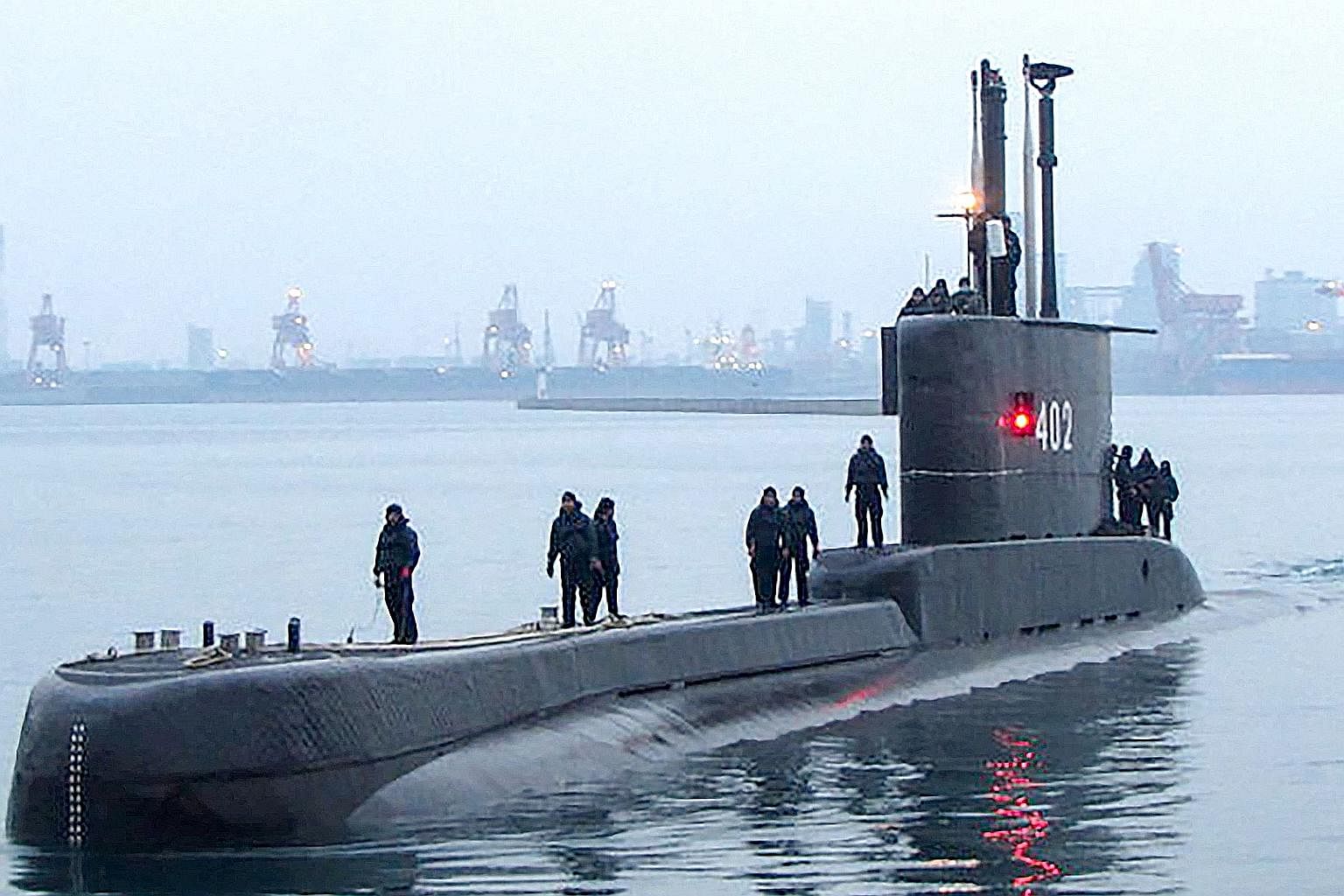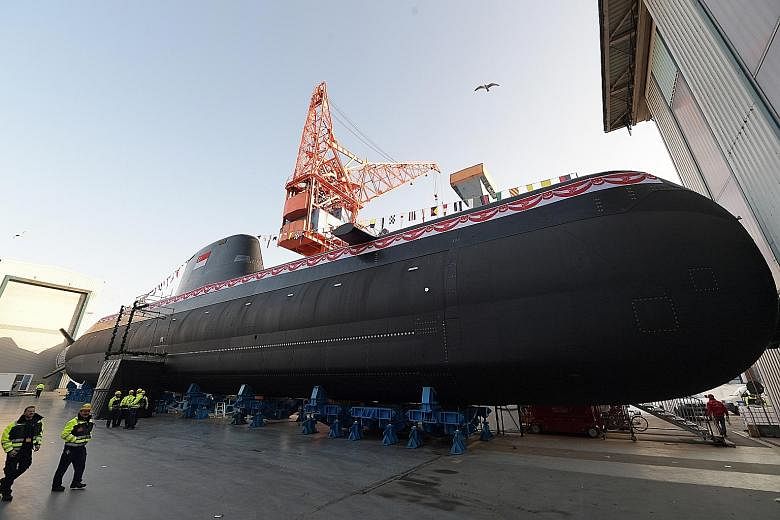SINGAPORE - Often called the silent service for their ability to stay undetected while stalking enemy vessels, submarines have played decisive roles in major conflicts for over a century, since the Germans used U-boats to devastating effect in World War I.
But the recent sinking of the Indonesian submarine KRI Nanggala 402 has turned the spotlight on the perils involved in operating these complex machines of war, designed to be "ship killers" that operate for long stretches in an unforgiving underwater environment.
The loss of the 53 crew members on board the Nanggala in April after losing contact during a training exercise was the fourth recorded accident since 2000 where an entire submarine crew has perished.
In 2017, the Argentinian submarine ARA San Juan with its crew of 44 went missing off the country's coast while on a training exercise. Its wreckage was found a year later.
In 2003, a Chinese submarine was in the sea off north-eastern China when the diesel engine failed to shut down as the boat submerged and all the oxygen was used up, killing all 70 on board.
The nuclear-powered Russian submarine Kursk sank in the Barents Sea in 2000 after an explosion, with no survivors among its crew of 118.
The many risks for submariners include those posed by the literal high-pressure undersea environment, which provides razor-thin margins of error. An incident such as a fire on board or a power failure can quickly escalate and become catastrophic.
So why do Singapore and other South-east Asian countries continue to acquire and operate these assets, with even the smaller regional navies finding the risks worth their investment?
The answer lies in the strategic nature and versatility of these deep-diving predators, which have proven their pedigree in naval history.
While the earliest submarine prototypes go as far back as the 16th century, they first came to prominence as a military weapon during World War I, when they mainly played the role of commerce raiders.
Then, the German U-boats - short for Unterseeboot - sank about 5,000 mostly merchant and civilian ships that ferried crucial supplies to the British.
In World War II, submarines became more multipurpose and lethal, adding visual surveillance of enemy shores and the insertion of secret agents or special operations forces to their repertoire, said Mr Ben Ho, a research fellow at the S. Rajaratnam School of International Studies (RSIS).
American submariners, for instance, never made up more than 2 per cent of the United States Navy's total force during World War II, but the vessels which they operated accounted for over 55 per cent of all Japanese ships sunk in the Pacific, according to Mr Don Keith, who wrote the book Final Patrol: True Stories Of World War II Submarines.
In present times, Mr Ho said, the typical attack submarine is like a Swiss Army knife entrusted with a variety of missions, as opposed to its rarer ballistic-missile cousin whose raison d'etre is nuclear deterrence.
"The submarine is a highly versatile platform which - through its stealth and ability to spring surprises - provides an asymmetric edge to its operator, even a weak one facing up to a strong opponent a la David versus Goliath."
Citing an example of submarines' strategic impact, RSIS research fellow Collin Koh said the British HMS Conqueror's sinking of the Argentine cruiser ARA General Belgrano in the 1982 Falklands conflict between the two countries left a deep impact on Bueno Aires.
"The Argentine Navy surface fleet, including its sole aircraft carrier ARA Vienticinco de Mayo, was confined to port and did not sortie (deploy) for the remainder of the conflict," he said.
As for Singapore, it entered the depths with the commissioning of the RSS Conqueror in July 2000. The Republic of Singapore Navy currently operates four refurbished Challenger- and Archer-class submarines.
They will be replaced by four advanced, custom-built Type 218SG submarines by German defence contractor thyssenkrupp Marine Systems, the first of which is slated to be delivered starting next year.
Regional countries such as China, India and South Korea also have plans to expand their submarine fleets.
Closer to home, Vietnam operates the largest fleet in South-east Asia with six subs. Indonesia had five before the recent sinking. Malaysia operates two and Thailand has one on order.

The Philippine Navy has repeatedly made its case for building up a submarine force. Myanmar was gifted a Soviet-era submarine by the Indian Navy last year.
Dr Koh believes even a tiny, "token" fleet matters as it could serve as a deterrent, although he cautioned that even a small force could be costly to acquire, operate and maintain.
He cited the US' confrontation with Libya's Muammar Gaddafi regime in the 1980s, where the US Navy was concerned about the latter's tiny fleet of Soviet-built submarines, despite their poor state of readiness.
Australia was also concerned about the potential challenge posed by Indonesia's two Cakra-class subs, including the ill-fated Nanggala, when it led a multinational peacekeeping force in East Timor in 1999, added Dr Koh.
"Even a small submarine force would be a worthy investment in the eyes of South-east Asian navies, which are typically small and weak compared with their more powerful regional counterparts," he added.
Put another way, a submarine is like a mobile minefield that injects uncertainty into an enemy's planning, as it represents an elusive yet deadly threat, said Submarine Institute of Australia secretary Frank Owen, who served in the Royal Australian Navy for 31 years.
Dr Koh added: "Classical threat perceptions don't necessarily constitute the key or only driver behind the quest for submarines in South-east Asia; it's also as much about catching up with the Joneses, as seen in the case of Thailand, for example.
"It's not so much about neighbours' submarines posing a real threat as the fact that if you don't acquire submarines too, you risk lagging behind in the effort to build a modern, balanced fleet."
While they punch above their tonnage, submarines confront a variety of operating risks, even as they are typically manned by some of the most elite military professionals selected through a rigorous process. The biggest risk is collisions, said Mr Owen.
A submarine can almost never be seen by a surface ship, he said. Even when it surfaces, a submarine's silhouette is small.
When underwater, it relies on hearing the noises made by other ships, but the sound might be distorted so a submarine may not hear anything as it returns from deep until it is too late, he added.
In 2001, the US submarine USS Greeneville collided with a Japanese fishery ship as it surfaced from a dive, causing the ship to sink and killing nine of the 35 people on board, including four high school students.
Like a warship, a submarine has instruments and sensors to keep it safe even in tough conditions. But unlike a ship on the surface that will stay afloat as long as the hull is intact, it is inherently less safe.
On a submarine, small mistakes can have disastrous consequences because emergencies do not happen in isolation, said Mr Anil Jai Singh, a senior vice-president at thyssenkrupp Marine Systems.
"One thing leads to another, which could become catastrophic if not addressed correctly and in time. At times even the best reaction may not salvage the situation which develops very rapidly," he said.
This means even a small problem can rapidly spiral and cause the crew to lose control of the submarine, or cause the boat to lose neutral buoyancy and sink, said Mr Bryan Clarke of the Washington-based Hudson Institute.
Mr Singh said the two most major emergency situations are either a major flooding through a ruptured pipeline or hull damage, or a major fire on board that can lead to total power failure, internal explosion, smoke and suffocation or rising water levels inside the submarine.
While there are redundancies built into critical systems, these can fail, he added.
The high-pressure environment means a hull breach can produce a jet of water that is many times the force a surface ship might experience, said Mr Owen.
"Any flood at depth quickly becomes uncontrollable and the weight of water taken into the submarine can rapidly exceed the buoyancy that emptying the ballast tanks might provide."
Mr Singh, a former submariner in the Indian Navy for 28 years, surmised that in the case of the Nanggala, assuming it was diving at a conservative speed of 5 knots with a down angle and lost power, it would have taken less than three minutes for the vessel to hit the bottom at 850m below depth, where it was found.
"Add to that complete darkness on board, emergency systems not responding and the foreboding in the crew that they are hurtling down rapidly beyond the submarine's crushing depth.
"These hazards do not differentiate between wartime and peacetime so the risk is omnipresent whenever a submarine puts to sea."


